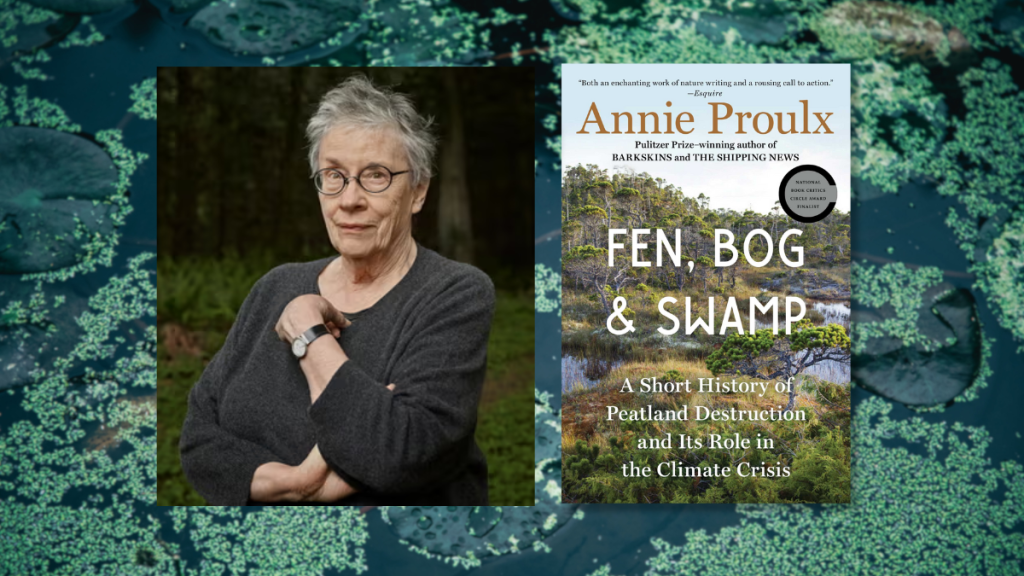Admittedly, I feel more at ease among towering limestone cliffs in Conservation Areas like Rockwood, Mount Nemo, Rattlesnake Point, Kelso, Niagara Glen, or Mono Cliffs (the Duncan Escarpment Caves are still on my to-hike list). There is something comforting about the sedimentary reminder that shakes loose assumptions about the urgency of the climate at present for a moment of relief from climate anxiety. I find the reminders of the planet being here before in this warmed and warming era, tucked away like paragraphs written into the geological record, comforting. I had not considered the equally crucial role that the seemingly less towering wetlands played in this same story written upon geological archives.
Reading Annie Proulx’s book Fen, Bog, and Swamp lent new appreciation for the lands whose historicity and impact is largely out of view aside for its support of biodiversity above. Even recent sojourns to Laurel Creek Conservation Area saw me bypassing the wetland in favour of the beach, and densely packed conifers leading away from the reservoir’s shores. Fens, bogs, and swamps seldom make for algorithmic darlings of social media fodder, but they serve a life-giving purpose: they contain CO2, as well as provide crucial breeding grounds for birds and wildlife seeking shelter from predation. They also act as containers where dangerous flooding would otherwise creep across landscapes, unbidden by nature’s guardrails. The threat is not in their existence and minor alteration, but in the draining of swamps, the bulldozing of marshlands in favor of development, and the subsequent ecological impacts (Proulx writes about the importance of the steadily declining Mangrove trees for example). She writes that “the tropical swamp forests hold as much as a third of the earth’s underground carbon reserves. Cutting, burning, and converting these forests to palm nut oil plantations, as people are now doing in Indonesia, releases gargantuan amounts of CO2” (p.166). The future of humanity is, whether we like it or not, intricately connected with the future of wetlands. Proulx’s book offers much in the way of an introduction to these crucial landscapes.
Proulx’s book is well-described as an erudite offering (though calling a Pulitzer Prize winning writer “erudite” feels like an insult to their craft), but the benefit is that her extensive environmental knowledge meets with accessible science, and cultural storytelling. It is a subject that is locally relevant where wetlands in Waterloo-Wellington, Caledon, and throughout the Niagara Escarpment face draining and bulldozing (or changes to the water table from mining leaving them irreparably damaged). This is to say nothing of the wetlands threatened in the Credit River Watershed by Doug Ford’s 413 highway project. Science underpins the concentrated storytelling that upholds the vast history of wetlands. For example, “a sphagnum specialist counted as many as 50,000 plants in a square meter of hummocky bog. That adds up to 1,500,000,000 thriving bits of life in every square meter” (p.93). In other words, these are natural areas teeming with life, intricately connected to our survival.
I do offer a caveat lector for any squeamish readers: the bog chapter pays significant homage to “bog bodies.” Evidently bogs have, in addition to climate effects, been a source of historical information on varied sites of cultural significance. In fairness, Proulx introduces the topic of fens, bogs, and swamps as a favourite tool in a horror writer’s landscape grimoire. She does not go into gruesome detail, but it does show how bogs were a culturally and spiritually significant site for sacrificial traditions. It vividly paints a portrait of the mind of those who view the bog as a still-liminal-interface that interacts with this world and the next.
In the positive register of literary caveats however, I greatly appreciated the injecture of Robin Wall Kimmerer’s work and research into Proulx’s writing. Beyond Kimmerer alone, there was recognition given to Indigenous histories in wetlands as well. Reading from Southern Ontario, within the Haldimand Tract insists upon a recognition of Indigenous stewardship and history. Proulx doesn’t give an in-depth treatment of this that might signify a tokenistic view but does include Indigenous histories as meaningfully as I’ve come to understand a settler might, when writing from their entangled and complicated relationship to nature in North America.
Proulx writes of human history as largely connected to Western economic imperatives of dominion, domination, and modernity. It is an “unremitting domination of every other species, of ceaseless modification and reshaping of the natural countryside to facilitate the taking of whatever is in the natural world that will make wealth” (p.49). Given the exponential growth of metropolitan areas that are tightening the Greenbelt in Southern Ontario as a too-small piece of clothing that tries to contain developmental multitudes, the sentiment in her book is #relatable.
I highly recommend this book not for its science alone, but because it lives up to its titular aim of being “A Short History of” where it narrates the intricate links between these landscapes and humanity. We may not notice fen, bog and swamp in the cast of everyday characters the minutiae of everyday meets with, but we can be certain that our way of life operates in tandem with these critical infrastructural marshscapes. Where “nature abhors a vacuum” for many, these wetland spaces empty of the vestiges of modernity and machinery are as much a part of the human story as skyscrapers rivaling coastal redwoods. Indeed, as Proulx demonstrates, they are a technology that our cultural and scientific imaginaries continually bow to at the ecological altar of mimesis. Summer reading for non-fiction nerds, or ecology geeks, Proulx has written a short but succinct tome honoring mutually constitutive wetland history and relations between nature and humans.
If you’re looking to visit some of these wetlands and appreciate them as you educate, don’t forget that you can place a Grand River Conservation Area and Ontario Parks Pass on hold with your Waterloo Public Library card.
Author image source: TheGuardian.com
